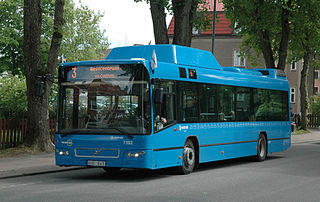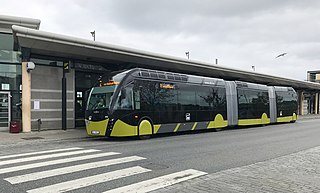
Vilnius is the capital and the largest city of Lithuania, with a population of 591,632 as of 2023. The population of Vilnius's functional urban area, which stretches beyond the city limits, is estimated at 718,507, while according to the Vilnius territorial health insurance fund, there were 753,875 permanent inhabitants as of November 2022 in Vilnius city and Vilnius district municipalities combined. Vilnius is situated in southeastern Lithuania and is currently the second largest city in the Baltic states. It is the seat of Lithuania's national government and the Vilnius District Municipality.

Solaris Bus & Coach is a Polish producer of public transport vehicles, with its headquarters in Bolechowo-Osiedle near Poznań. It is a subsidiary of Spanish CAF. Solaris owns four production sites: its main factory and headquarters in Bolechowo, two plants in Środa Wielkopolska as well as a final assembling hall for rolling stock, located in Poznań, in Wieruszowska street.

Public buses form a significant part of public transport in Singapore, with over 3.6 million rides taken per day on average as of December 2021. There are 352 scheduled bus services, operated by SBS Transit, SMRT Buses, Tower Transit Singapore and Go-Ahead Singapore. The newest bus operator, Go-Ahead Singapore started operation on 4 September 2016. There are also around 5,800 buses currently in operation as of 2020.

An electric bus is a bus that is propelled using electric motors as opposed to an internal combustion engine. Electric buses can store the needed electricity on board, or be fed continuously from an external source. The majority of buses storing electricity are battery electric buses, where the electric motor obtains energy from an onboard battery pack, although examples of other storage modes do exist, such as the gyrobus which uses flywheel energy storage. When electricity is not stored on board, it is supplied by contact with outside power sources. For example, overhead wires as in the trolleybus, or with a ground-level power supply, or through inductive charging.

Marshrutka or marshrutnoe taksi or routed taxicab, are share taxis found in Eastern Europe and the republics of the former Soviet Union. Usually vans, they drive along set routes, depart only when all seats are filled, and may have higher fares than buses. Passengers can board a marshrutka anywhere along its route if there are seats available.

A midibus is a classification of single-decker minibuses which are generally larger than a traditional minibus but smaller than a full-size single decker and can be anywhere between 8 metres and 11 metres long. While used in many parts of the world, the midibus is perhaps most common in the United Kingdom, where operators have found them more economical, and to have a sufficient number of seats compared to full size single-decker buses.

Šeškinė is a fairly new district located in the north of Vilnius, the capital of Lithuania, built in 1977 as a microdistrict. It is located to the east of Justiniškės district, to the south and south-east of Žvėrynas and Šnipiškės elderships, to the north of Fabijoniškės and Pašilaičiai districts, and to the west of Verkiai district.

The Košice public transit system operates in Košice, Slovakia; services are managed by the Košice Transit Company.

Dopravný podnik Bratislava, akciová spoločnosť is the only provider of city public transport in Bratislava. It provides 3 types of transportation:

A single-decker bus or single-decker is a bus that has a single deck for passengers. Normally the use of the term single-decker refers to a standard two-axled rigid bus, in direct contrast to the use of the term double-decker bus, which is essentially a bus with two passenger decks and a staircase. These types of single-deckers may feature one or more doors, and varying internal combustion engine positions. The majority of single-deckers have a length of up to 12 metres, although some exceptions of longer buses exist. They also typically weigh between 11 and 14 tons.

Public transport in Tallinn consists of bus, tram, trolleybus, train and ferry services. Bus, tram and trolleybus routes are mainly operated by Tallinna Linnatranspordi AS. Electric train services are offered by Elron and the ferry service to Aegna island is operated by Kihnu Veeteed.

Warsaw has seen major infrastructural changes over the past few years amidst increased foreign investment and economic growth. The city has a much improved infrastructure with new roads, flyovers, bridges, etc. Public transport in Warsaw is ubiquitous, serving the city with buses, tramways, urban railway and Metro.
Rocar was a van, light truck, bus and trolleybus manufacturer based in Bucharest, Romania. The firm also produced light offroad vehicles and later heavy road vehicles. During its existence, the company produced over 350,000 vehicles.

The Vilnius trolleybus system is the one of two existing trolleybus systems in Lithuania. It operates in the capital city of Vilnius, the municipal operator company is Vilniaus viešasis transportas Ltd. 188 trolleybuses are working on working-days, 106 - on weekends.

The Volvo 7000, later Volvo 7700, was an integrally-constructed fully low-floor single-decker rigid bus and single-decker articulated bus built by Volvo between 1999 and 2012. It was generally available as 12-metre and 18-metre on both diesel and CNG, and from 2010 as a 12-metre hybrid electric. A trolleybus version has also been built.
The following is a timeline of the history of the city of Vilnius, Lithuania.

Vilnius Central Railway Station is a Lithuanian Railways passenger station in Vilnius, Lithuania. The railway station situates between two neighbourhoods of Vilnius - Naujininkai and Naujamiestis and on the edge of the Old Town.

The Volvo 7900 is an integrally-constructed single-decker rigid bus and single-decker articulated bus, most commonly available as a hybrid electric bus named Volvo 7900 Hybrid or just Volvo 7900H, but is also available with both diesel and Compressed Natural Gas (CNG) engines in some markets. It is manufactured at Volvo's plant in Poland. It was introduced at Busworld Kortrijk 2011. Based on the Volvo 7900 Hybrid an extension is offered, which i.a. includes a roof-mounted device for occasional loading at stops. The manufacturer assumes that all buses at all end stations and also at some particularly busy stations stay a few minutes until the return or onward journey. As soon as a bus reaches an appropriately equipped stop, a loading unit attached to a pillar at the roadside lowers onto the coupling point mounted on the roof of the bus. The charging process ends as soon as the bus wants to continue or the battery is full. According to the manufacturer, this equipment allows compared to conventional hybrid buses significantly extending the travel time in electric mode and a reduction in fuel consumption. The vehicle and the charging system were first presented to the public in September 2014 at the International Motor Show.

Solaris Urbino 18 is a low-floor articulated version of the Solaris Urbino series buses designed for public transport, produced by the Polish company Solaris Bus & Coach from Bolechowo near Poznań in Poland. It is the second most popular Solaris model in terms of the number of units sold. Since 2005, the third generation of the Urbino 18 is produced. In addition to the basic model, which is powered by a diesel engine which meets the Euro V emission standard, there are versions produced to meet the EEV and fueled with CNG or the second generation hybrid bus model.

AtB AS is a public transport manager for Trøndelag and is managed as a corporation. AtB's task is to plan, order, market and develop public transport in the county. Tariffs are set by the county council as part of the budget process. AtB has three main sources of funding: Ticket revenues, grants from the Trøndelag County Municipality and the Environmental Package. AtB has a customer center at Prinsens Gate 41 right beside the bus stop Prinsens Gate P2 in Trondheim. AtB took over as public transport manager for bus traffic in Trondheim in 2010, tram traffic on Gråkallbanen and other bus traffic in Sør-Trøndelag in 2011, speedboat routes in 2012 and 2014, ferries in 2015, and in 2018, the former Nord-Trøndelag was also incorporated after the two counties was merged into the new county of Trøndelag.






















